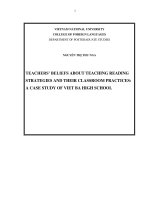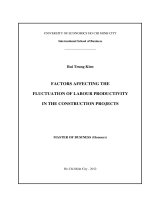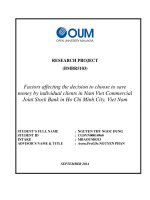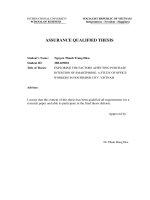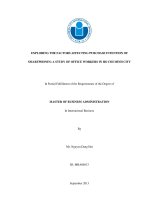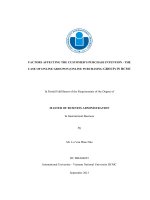Exploring major factors affecting the teaching of music education in primary schools the case of four primary schools in addis ababa
Bạn đang xem bản rút gọn của tài liệu. Xem và tải ngay bản đầy đủ của tài liệu tại đây (466.17 KB, 90 trang )
Exploring Major Factors Affecting the Teaching of
Music Education in Primary Schools:
The Case of Four Primary Schools in Addis Ababa
Tigist Getachew
A Thesis Submitted to
Center for African and Oriental Studies
Addis Ababa, Ethiopia
June, 2017
I
Exploring Major Factors Affecting the Teaching of
Music Education in Primary Schools:
The Case of Four Primary Schools in Addis Ababa
Tigist Getachew
A Thesis Submitted to
Center for African and Oriental Studies
Presented in Partial fulfillment of the requirements for the Degree of Master
of Arts in African Studies (African Intellectual History and Cultural Studies)
Addis Ababa, Ethiopia
June, 2017
II
ADDIS ABABA UNIVERSITY
COLLEGE OF SOCIAL SCIENCE
CENTER FOR AFRICAN AND ORIENTAL STUDIES
EXPLORING MAJOR FACTORS AFFECTING THE
TEACHING OF
MUSIC EDUCATION IN PRIMARY SCHOOLS:
THE CASEOF FOUR PRIMARY SCHOOLS IN ADDIS ABABA
TIGIST GETACHEW
ADVISER
GETACHEW KASSA(Phd)
A Thesis Submitted to the Center for African and Oriental Studies of Addis Ababa
University
III
Presented in Partial Fulfillment of the Requirements for the Degree of Master of Arts in
African Studies (Intellectual History and Cultural Studies)
June, 2017
Addis Ababa
IV
Addis Ababa University
College of Social Science
Center for African and Oriental Studies
This is to certify that the thesis prepared by Tigist Getachew, entitled: Exploring Major
Factors Affecting the Teaching of Music Education in Primary Schools:The Case of
Four Primary Schools in Addis Ababa and submitted in Partial fulfillment of the
requirements for the Degree of Master of Arts in African Studies (Intellectual History
and Cultural Studies), complies with the regulations of the University and meets the
accepted standards with respect to originality and quality.
Signed by the Examining Committee:
______________________
_______________
________________
External Examiner
Signature
Date
______________________
_______________
________________
Internal Examiner
Signature
Date
______________________
_______________
________________
Signature
Date
Advisor
V
ACKNOWLEDGEMENTS
I have to thank many people for help required for this thesis. I would like, at the start, to thank Kotebe
Metropolitan University for offering the chance to pursue my study.
I am most grateful to my supervisor Dr. Getachew Kassa for his generous comments and
encouragements throughout the research period. I am also grateful to Sister Hirut Tesfaye for her
unreserved comment on my research. I would like to thank my husband Ato. Zelalem Gudeta. I’m also
grateful for my lovely mother Esetesellassie T/Tision and my family members: Tadelech, Eyob,
Wondifraw, Genet, Mebratu, Lidya, Dagim, Teketelew, Tigist and Marianne.
I would also like to express my profound gratitude to my colleagues: Million Yohannes, Yazew Abera,
Meskerem Zeray Simegnesh Teklay and her husband Araya Demisse for their invaluable support
during my study.
I
TABLE OF CONTENTS
List of contents
Pages
ACKNOWLEDGEMENTS .............................................................................. I
TABLE OF CONTENTS ................................................................................ II
ABSTRACT ................................................................................................... VI
DEFINITION OF KEY TERMS .................................................................. VII
CHAPTER ONE ............................................................................................... 1
1.1 Background of the Study ............................................................................................ 1
1.2 Statement of the Problem........................................................................................... 2
1.3 Research Questions ..................................................................................................... 3
1.4 Objectives of the study ............................................................................................... 3
1.4.1 Major Objective ....................................................................................................... 3
1.4.2 Specific Objectives .................................................................................................. 4
1.5 Significance of the Study .......................................................................................... 4
1.6 Scope of the Study ...................................................................................................... 5
CHAPTER TWO .............................................................................................. 6
2. Review of Related Literature ....................................................................... 6
2.1 Music Education and its Various Approaches ............................................................ 6
2.2 Major Features of African Music................................................................................ 9
2.3 Benefits of Music Education for Various Academic Activities ............................... 10
2.4 The Integration of Music with other Subjects .......................................................... 11
2.5 Music and Language Skills ....................................................................................... 12
CHAPTER THREE ........................................................................................ 14
3. Research Methodology ............................................................................... 14
3.1 The Research Design ................................................................................................ 14
3.2 Source of Data .......................................................................................................... 14
3.3 Population and sampling procedure.......................................................................... 14
II
3.4 Instruments of the study............................................................................................ 15
3.4.1 Questionnaire.......................................................................................................................... 15
3.4.2 Structured Interviews ............................................................................................................. 15
3.4.3 Classroom Observation .......................................................................................................... 16
3.4.4 Focus Group Discussion......................................................................................................... 16
3.4.5 Text Books’ Content Evaluation ............................................................................................ 17
3.5 Data Collection Procedure ........................................................................................ 18
4. Results and Discussion ............................................................................... 19
4.1 Analysis and Interpretation of data .......................................................................... 19
4.2 Major Findings of Teachers ‘questionnaire .............................................................. 25
4.3 Major Findings from the students’ Questionnaire .................................................... 27
4.4 Major Findings of Administrators questionnaire ...................................................... 27
4.5 Major Findings of the Administrators’ Interview ..................................................... 30
4.6 Major Findings of the Experts Interview .................................................................. 33
Teachers’ Performance in Music Education ................................................................... 33
4.7 Major Findings from Instructors’ Interview ............................................................. 35
4.8 Major Findings of the Classroom Observation ......................................................... 40
4.9 Major Findings from Students’ Focus Group Discussion ........................................ 42
4.10 Major Findings of Instructors’ Group discussion ................................................... 42
4. 11 Major Findings of the Text Book Evaluation (Grade 1-4) .................................... 50
4.12 Major Findings of the text books’ evaluation (Grade 5 and 6)............................... 54
CHAPTER FIVE ............................................................................................ 56
5. Summary, Conclusion and Recommendations........................................... 56
5.1 Summary ................................................................................................................... 56
5.2 Conclusion ................................................................................................................ 57
5.3 Recommendations..................................................................................................... 58
REFERENCES ............................................................................................... 60
APPENDICES ................................................................................................ 63
Appendix 1: Teachers’ Questionnaire ............................................................ 63
Appendix 2: Students’ Questionnaire ............................................................ 68
III
Appendix 3: School Administrators’ Interview ............................................. 70
Appendix 4: Focus group discussion with instructors and Experts in Educational
Bureau and Ministry of Education ......................................................... 71
Appendix 5: Focus Group Discussion with Students ..................................... 72
Appendix 6: Data from School Administrators’ Questionnaire.................... 73
Appendix 7: በተማሪዎች
የሚሞላ መጠይቅ .......................................................... 74
Appendix 8: ከተማሪዎች ጋር
የተደረገ የቡድን ውይይት .................................... 75
IV
LIST OF TABLES
Table 4.1: Background of Teachers ............................................................................................ 19
Table 4.2 The Relevance of music education and the appropriateness of contents in the text
books.................................................................................................................................... 20
Table: 4.3 Music Teachers’ General concept about Music Education. ...................................... 21
Table: 4.4 Vocal and Instrumental Skills of Music Teachers ..................................................... 22
Table: 4.5 School Administrators’ support for teachers ............................................................. 23
Table: 4.6 Contents of the current music education text books 24
Table 4.7 Developing contents of the text book ......................................................................... 25
Table 4.8 Appropriateness of the Text Book .............................................................................. 26
Table: 4.9 Grade one text book ................................................................................................... 44
Table: 4.10 Grade Two Text Book ............................................................................................. 45
Table: 4.11 Grade Three Text Book ........................................................................................... 47
Table: 4.12 Grade Four Text Book ............................................................................................. 48
Table: 4.13 Grade Five Text Book ............................................................................................. 52
Table: 4.14. Grade Six Text Book .............................................................................................. 53
V
ABSTRACT
This study is an attempt to gain insight into the major factors affecting the teaching of music education,
in primary schools and to find out solutions for the existing problems. Thus, an exploratory approach
with qualitative and quantitative methods has been used to carry out the study. The main subjects of the
study were eighty primary school students, twenty two primary school teachers, four school
administrators, two higher institution instructors, and experts from the Ministry of Education and
Addis Ababa City Administration Educational Bureau. Samples were selected using purposive
sampling method. Data on the research topic were gathered by means of questionnaires, interview,
classroom observation, focus group discussion, and text books’ content evaluation (grade one up to
six). Analysis of the data indicated that there are certain critical problems which affect the teaching of
music education in the current primary schools. Most of the problems are related to: teacher’ training
policy, teachers’ performance in the field, text books’ content organization, lack of musical
instruments, availability of text books, society’s attitude to the subject matter and teachers’ motivation
towards music education. The study concludes by forwarding recommendations and considering some
pedagogical implications to the teaching of music education in primary schools.
Key words:- Ethiopia, Music Education, Primary schools and Teaching Methods
VI
DEFINITION OF KEY TERMS
1. Chord: - (music) A harmonic set of three or more notes that is heard as if sounding
simultaneously.
2. Dynamics: - (music) The volume of the sound, such as piano, mezzo piano, mezzo forte and
forte.
3. Folk song:-A song originating among the working people of urban and rural areas, and handed
by oral tradition.
4. Flat: - (music) of a note or voice, lower in pitch than it should be.
5. Harmony:-arrangement of sounds two or more notes played simultaneously.
6. Lyrics:-The words of a song or other vocal music.
7. Melody:-Sequence of notes that makes up a musical phrase.
8. Major scale:-One of the diatonic scales; a group of notes or musical pitches in a particular
pattern used to make melodies. The pattern for a Major scale is:
Tone –tone-semitone-tone-tone-tone-semitone
In the key of C Major, this produces a scale with the notes C,D,E,F,G,A,B,C
9. Minor scale: - (music) A diatonic scale based up on a relative Major scale by changing its tonic
note by three semitones.
10. Musical notations:-A system which represents aurally perceived music through the use of
written symbols.
VII
11. Natural: - (music) neither sharp nor flat denoted.
12. Scale: - (music) A series of note spanning an octave used to make melodies.
13. Semitone:- (music) The musical interval equal (exactly or approximately) to half a tone or
One-twelfth of an octave.
14. Sharp: - (music) Higher in pitch than required.
15. Staff (stave) :- (music) A series of horizontal lines on which musical notes are written.
16. Tempo:- (music) The number of beats per minute in a piece of music; also, an indicative term
denoting approximate rate of speed in written music (examples: allegro, andante)
17. Time signature: - (music) A numerical sign placed on the stave to indicate the meter, the
Numerator is the number of beats per bar, the Denominator represents the value of each beat.
18. Tone: - (music) a specific pitches.
19. Tune (kignit):-A melody or a song, or short musical composition.
VIII
CHAPTER ONE
1.1 Background of the Study
Education is both a means and process of transmitting knowledge and civilization of a society for the
present and the future generations with the view to facilitate the continuity of knowledge. (Okafor,
1988).
Music has various uses for the learners. It assists learners in releasing their emotions and expressing
their feelings, provides aesthetic enjoyment, entertainment, recreation and amusement, serves as
symbolic representation of a particular culture, stimulates physical responses, facilitates conformity to
social norms, validates social institutions and religious rituals, contributes to the continuity and stability
of culture, Music contributes to the integration of society. (Allyn and Bacon 1969).
The purpose of delivering music education is mainly to motivate young learners to learn other subjects
effectively and to enhance subject integration. (Adegbite, 1999)
The provision of music as a subject in Ethiopia began during the reign of Menelik II. The subject was
given for both elementary and secondary school students. The subject was continued till 1950 in both
primary and secondary grades. But the subject was given for the sake of curriculum fulfillment. (Ezra,
2002)
According to Ezra, (2002) at present the delivery of music education in the public and private schools
in Addis Ababa varies a lot. Some private schools teach music education at primary school level as a
subject. They also hire teachers who were trained in music discipline and who are qualified in the
subject matter of music and in music teaching. By contrast, in most public schools in Ethiopia in
general and particularly, in Addis Ababa City Administration still qualified professional music lesson
instructors did not employ to teach the subject.
Currently music education is given with an integration of Physical Education and Art under Aesthetic
department. But this trend has created difficulty in the implementation of music education and for the
effectiveness of the curriculum. (Martha 2010) The delivery of music education in most schools in
1
Addis Ababa also varies a lot. Some private schools teach music education beginning from primary
school levels as a subject. They also hire teachers who were trained in music discipline, who are
qualified in the subject matter. By contrast, most public schools in Addis Ababa city administration
have not been recruited qualified teachers in the field (Ezra 2010).
Moreover the subject has been given by non-professional teachers, trained in other field of
specialization. Hence, it seems that this issue needs to be taken very seriously. It needs to be resolved
immediately by the government and other stakeholders to implement music education in a scientific
way. Moreover, research should be carried out on the major challenges of music education, and how to
improve both the content and methodology of the subject matter.
According to Fafunwa, (1971) in most part of the world Songs have been used as a means to enhance
and facilitate learning objectives. It also plays a significant role to teach children. Music is the primary
element of the given society in various issues such as: socio-cultural heritage, cultural assets, virtue,
etc…. It also serves as a channel to advance and maintain other useful identities of the society to the
generations. It could also help to shape learners’ personality.
1.2 Statement of the Problem
The teaching of music education in most primary schools found to be unsatisfactory due to various
factors in relation to teachers, learners, and administrative bodies. The problem is manifested both in
public and private schools. Most teachers are untrained and school administrative bodies give little
attention for the subject matter. According to Ezra (2002) music education in Ethiopia have various
challenges such as: absence of skilled human power, lack of training, classroom size of students, and
lack of musical instruments. The curriculum and syllabus of music education also lacks its indigenous
nature. Meaning it could not inspire learners to discover their own culture and tradition in the contents
of the subject matter. This could attribute to the failure of the music education system. Many scholars
also agree that music education is not received adequate level of support it needs in the school. (Smith,
1985)
Moreover, the integration of music education has not been yet implemented in schools since music
education has a significant role to make contents of other disciplines more clear. According to Abate,
2
(2002:73) the concept of integration seems not well understood by the curriculum experts.
Music
education text books are also not well organized in ways which are suitable for the learners’ age level
and educational background. Concerned bodies also do not give serious consideration for the
implementation of the subject matter.
1.3 Research Questions
With the aim to find out the major factors affecting the teaching of music education in primary schools,
it is necessary to answer the following questions:
1.3.1 Major Research Questions
1. What are the major factors affecting the teaching of music Education in primary schools?
1.3.2 Specific research questions
1. What teaching methods are used by teachers?
2. What are the students’ difficulties in learning music education in classes?
3. How are the current music education text books organized in terms of content and methodology?
4. What contributions have been done so far by school administrators, and other concerned bodies, to
improve the teaching of music education?
1.4 Objectives of the study
1.4.1 Major Objective
The major objective of the study is to explore the underlying problems in the teaching of music
education, particularly in primary grades.(1-6)
3
1.4.2 Specific Objectives
The specific objectives are to:
•
Examine the current teaching methodologies used in music education.
•
Identify teacher, student, and other external factors which can be a threat for an effective
teaching learning process in music education.
•
Examine the effectiveness of music education text books in all primary grades (1-6).
•
Suggest some effective strategies that could help both teachers and students in the teaching of
music education.
1.5 Significance of the Study
The proposed study is hopped to generate useful facts and based policy ideas for music education in
primary schools .It will have a great value as, it tried to evaluate the existing practice and attitudes of
music Education. Teacher, administrative bodies, and other concerned bodies would also get a chance
to take some corrective measures in the teaching of music education. The concerned bodies would also
get some insights about the current development of music education and possible to make a revision in
the contents of text books, curriculum, syllabus and policies of music education, particularly in primary
grades. Moreover, it can serve as a base line to offer music lessons and instructions in primary schools.
Problems related to the implementation of music education in primary schools, particularly in Addis
Ababa were also identified, and possible solutions and recommendations were proposed for a better
implementation system in primary schools in Addis Ababa that will also enhance children academic
achievements.
4
1.6 Scope of the Study
This study focuses on identifying factors in the teaching of music education in primary schools of
Addis Ababa City Administration. Thus, the researcher is limited in time and obliged to conduct the
research in limited primary schools for classroom observation and micro teaching activities.
Problems related to the implementation of music education in primary schools, particularly in Addis
Ababa were identified, and possible solutions and recommendations were proposed for a better
implementation system in primary schools in Addis Ababa that will also enhance children academic
achievements. Most assigned teachers in music education were from other field of specialization. Due
to this fact, I was not able to get the intended data for my study.
In conclusion, this chapter briefly discussed the following points: the background of the study, the
study that explores the major factors affecting the teaching of music education in primary school,
statement of the problem, major and specific research questions, which helps to explore problems of
the research topic, the objective and scope of the study, and the significance of the study for music
education.
5
CHAPTER TWO
2. Review of Related Literature
This chapter reviews the literature in the area of music education and instruction. Issues such as what of
music education, the importance of music education and instruction, basic features of music education
etc…are reviewed in this chapter. Thus, it is hoped that the approaches reviewed in this chapter will
provide a theoretical base for the study.
2.1 Music Education and its Various Approaches
Different authorities in the field define the concept of music education and explain the various
approaches in different ways. For instance Yudkin (2008:12-13) defines ‘’Music education is a field of
study associated with the teaching and learning of music. It touches on all learning domains, including
the psychomotor domain (the development of skills), the cognitive domain (the acquisition of
knowledge), and in particular and significant ways, the affective domain (the learner’s willingness to
receive, internalize, and share what is learned’’
Current research in the field reveals that the global music instruction and approach in most world, from
preschool up to post-secondary school is very common and similar in content. The reason is that people
strongly believe that music is a distinctive feature of humans such as language and other social values
in the modern society.(Christopher and et al,2010)
Moreover; Yudkin (2008) says the involvement of music in school curriculum is considered as a
fundamental element of human culture and behavior.
According to Lee (2012) the middle of twentieth century was the exact time that so many distinctive
approaches were developed for the teaching of music education. Some of them have a global impact
even these days.
6
The Dalcroze method or eurhythmics, the Kodaly Method, the Orff Schulwerk approach, the Suzuki
method, the Carabo Cone method etc… are some of the major music teaching methods greatly
influenced our world. Lee (2012)
According to Riley and Chrisman (1990) the Kodaly method is greatly emphasized on the benefits of
physical instruction and response to music while the Orff Schulwerk approach directs learners to scale
up their performance in music in a way that is equivalent to the advanced world, western countries. On
the other hand, the Suzuki method creates the same learning environment as the learners acquire
knowledge in their native language.
The Gordon Music learning theory greatly helps the music teacher with a technique of teaching music
concepts through audition. The carabo Cone Method also involves using props, consumes, and toys to
learn basic concepts in music. This method is particularly suitable for children whose cognitive level is
incapable to perceive abstract concepts. This music teaching method also helps music teachers to teach
basic music concepts such as note duration, and the piano key board. D’souza (2013)
As Bosacki and Neill (2013) confirms in most American, European and Asian countries, children often
learn to play instruments such as key board, recorders, since from the lower grades. They also learn and
informed about basic elements of music and the history of music education. Children may often have
the opportunity to perform in some type of musical ensemble, such as a choir, orchestra, or school
band, concert band, marching band and Jazz band. In many schools of those countries additional music
classes are still conducted both in primary, secondary and post secondary high schools to support other
academic streams and remain as part of the school curriculum.
Moreover in most countries students at the tertiary level take music courses in art and humanity
programs such as; the history of music and music appreciation which focuses on listening and learning
various styles of music. (Bosacki and Neill, 2013)
When we come to our country’s context Ethiopia is one of the oldest nation in the world with various
music cultures both in secular and scared concepts. According to Zenebe (1987) Ethiopian music
trained and educational system is the result of the diverse fascinating culture of nations and
nationalities. The Hamitic, Semitic and Cushitic people have contributed a lot to the current music
development of the state.
7
According to Ashenafi (2012), ancient worship and superstition in Ethiopia such as ‘’the dragon king
‘and other sacrificial ceremonies were accompanied by music.’’ Ritualistic songs and dance was very
common in the early society. All these displays, the belief and worship of spirits formed musical
practices in the earliest society of Ethiopia. Later on these many years of cumulative musical
experience played a significant role for the birth of the current Ethiopian church’s ritual and hymns.
Research says, Yared was the one who got recognition for the current notations in Ethiopian songs.
He was the greatest of all Ethiopian music scholars, lived during the reign of King Gebre Meskel.
(Ashenafi, 2012) another research also manifested that there were two non ecclesiastic learned men,
Azaz Gera and Azaz Raguel, who introduced notations during the reign of Emperor Gelawdewos
(1508-1540) But still there is a controversial facts about these two music intellectuals. According to
Ashenafi (2012) these two scholars were civilians and they were far beyond the theological knowledge
and untrained in the practices of church belief. But still some people believe that notations were
introduced before saint Yared.
Regarding the modes of music, the secular and religious music in Ethiopia has a different mode and
style. According to (Zenebe, 1987) the secular music has been to have four modes called: Ingurguro,
Mezmur, Zefen, and Zema.
“Ingurguro” is a musical style which is found in a litany type of music. The song is primitive type that
anyone found it in each and every traditional folk music. It is also reflected in most of Ethiopian ethnic
groups. This is the type of song which is usually sung in a soft and sentimental manner.(Zenebe, 1987)
Songs of this type are not accompanied by hand clapping or drum playing. Song contents such as;
personal emotions, frustration, life experiences etc…. were manifested in the song type. In addition to
this the “Ingurguro” serves as a psychotherapeutic release for repressed emotions. Moreover, there are
no established texts or habits for the song, nor a distinction between men and women. But the aim of
singing the song might differ in its objective. Women usually sing the song doing their traditional
handy craft such as ‘sifet’ (wickerwork) and ‘wofcho’(grinding a stone) while men are singing when
they are getting frustrated and feel bad in different issues. (Zenebe, 1987)
8
The second style of Ethiopian music is ‘’Mezmur’’ which has a unique character from the rest music
modes. It differs from the rest of music styles that it is performed with a different rhythmical
restrictions and content limitations. The song has its own unique settings such as: funerals, sporting
games, Children’s songs and societal celebrations. Furthermore; it is performed in a high pitch and a
maximum emotion level. (Zenebe 1987)
The third musical mode in Ethiopia is ‘’Zefen’’ which is one of the most popular musical style in the
country. It is performed in a relaxed manner and accompanied by a dance and drum. It is also sung in a
full voice with a variety of song texts. (Zenebe, 1987).
The fourth type of musical mode is ‘’Zema’’which is mostly confined to ecclesiastical and hymn songs.
We found such a song, in church services such as in “Kidasse” and “Sahitat” “Zema” by its nature has
similar rhythmic characteristics with “Ingurguro” and “Mezmur” “Woreb” is also equated with the
“Zefen” secular style of music. The difference lies on only in its musical modes and psychological
implications. (Zenebe, 1987).
2.2 Major Features of African Music
Like all other parts of the world African music has its own unique feature in its combination. Call and
response, the dense quality of the music (overlapping texture) and the cyclical and open ended form of
the music are the three major features of African music. (O’Conor, 2010).
According to O’Conor, (2010) call and response is a very common music practice in all over sub
Saharan African Society. African music has also a dense overlapping texture, which greatly contributes
for the sound quality of the music. The cyclical open ended nature of the music also distinguishes
African music from the rest part of the world. Meaning one or more repeated melodies or rhythmic
patterns or ostinatos used as the basic foundation of the performance.
Furthermore, Community participation has a great value in most African music traditions. Non
specialized participants would also be given a chance to enter and perform musical activities.
Repetition and intensive participation are also basic features of African music.(Ashenafi, 2012)
9
2.3 Benefits of Music Education for Various Academic Activities
It is obvious that Music is an invaluable to human culture. It is a part of people's daily lives around the
world. It allows people to connect with each other and with themselves to discover a deeper meaning of
human emotions and interactions ( Rauscher, 2000) Music Education is a necessary means by which
all students can express themselves and discover their own emotions. A music classes would give
opportunities for the learners to grow: emotionally, mentally, and physically. It also works as a support
system for peer interactions. (Azzara, 2012).
According to Azzara (2012), music Education provides necessary life skills such as: self-discipline,
self-expression, responsibility, patience, and teamwork. Music Education is a way to instill a love of
music that will carry on for the rest of students’ lives. Different researchers and music education
advocators have argued that studying music enhances academic achievement, (Joane, 2012) Different
authors have claimed that "Music enhances knowledge in the areas of mathematics, science,
geography, history, foreign languages, physical education, and vocational training. (Morrison, 1994)
Researchers at the University of Wisconsin suggested that students who played a piano or a keyboard
before the exam
performed better than those who didn’t play. Particularly in spatial-temporal lobe
activity, this is the part of the brain that is used when doing mathematics, science, and engineering.
(Rauscher and Zupan, 2012)
According to Wallace (1994), music has also a great relevance in recalling contents of the subject
matter. Regarding this issue a research has made by forming an experimental and control group. Three
groups were made and the first group was made to learn their lesson with a three verse song with a nonrepetitive melody. The second group was made to carry out their study with a repetitive melody. The
third group performed their task totally without music. And finally the result was revealed that the
controlled group, those who learned their lesson with music performed better than those who
performed their activity without music.
Another research was conducted in word list memorization. Two groups were made for the study. The
first group was made to memorize words with back ground music and the second group was made to
memorize words with a back ground music. This research was also revealed that those group of
learners carried out their activity with a back ground music were able to memorize more words with a
10
better efficiency. The back ground music was also made them to retrieve their knowledge and to have a
contextual meaning. (Smith, 1985)
Moreover, (Morrison, 1994) also confirms that music education has contributed a lot for the
development of academic achievement. Music has played a significant role for the intellectual and
academic development of learners. It also creates better academic environment for the learners
particularly for children at younger ages.
Bobbett (1990) also suggests that music and art contributes a lot for the society to overcome
misbehaved citizens. For instance citizens who are addicted in alcohol, tobacco and drugs showed a
promising changes when they engaged in Musical performances such as band and orchestra. Thus it is
clear that music education is a means to recover the normal mind status of individuals in who are in
acute problems.
2.4 The Integration of Music with other Subjects
Many schools and educational sectors strongly suggest the integration of art classes such as music with
other disciplines like: foreign languages, history, geography, physical education, mathematics, science
and vocational training. The strong belief is that integrating different curricula with music will
definitely bring up a change in the learners’ academic performance. It also enhances the overall quality
of education.
Many students in the world have a learning difficulty in one or another ways. Research shows that
music has a great relevance to overcome those challenges and to enhance the cognitive level of
students. In the United States of America an estimated 30% of students are still struggle with reading,
un able to understand the gist of a certain text while 17% of the learners have shown a learning
disability linked with reading. (Register et al., 2007).
According to Overy (2000) Students engaged in music curriculum brought a remarkable change in
reading comprehension, word power, vocabulary recall and word decoding. Music education has also a
great advantage to support children with dyslexic read and write problems disability, visual, auditory
and fine motor skill disabilities. (Butzlaff, 2010).
11
Schellenberg (2004) also confirms that Music education has also been noted to have the ability to
increase someone’s overall IQ, especially in children, during their peak development years. Special
ability, verbal memory, reading and mathematical abilities are seemed to be increased when they are
given interactively with music education. Researchers also noted that the general attendance and IQ
would also increase when they are integrated with music education. Motor skills, social behaviors, and
the emotional well being of the learners will dramatically increase through music and music education.
According to Bosacki and O’Neill (2013) learning musical instruments increase the ability of students’
fine motor skill, particularly those in physical disabilities. Emotional well-being can also be increased
as students find meaning in songs and other rhythmic works. Musical activities like playing jazz and
concert bands would also scale up the learners emotional and mental well-being. In doing so learners
also will come to learn how to socialize and interact with their surrounding community.
2.5 Music and Language Skills
Teaching children through music is the most rewarding profession, and being able to share love of
music with students would be the most amazing job one could ever ask for. Bosacki and O’Neill
(2013).
One of the breakthroughs in this area is that music’s benefit for language development, which is so
important for children to acquire basic language skills easily. While children come to the world, they
are ready to decode sounds and words. Music education helps enhance those natural abilities.
According to Colwell, (1992) “Growing up in a musically rich environment is often advantageous for
children’s language development.” And of course those inborn capacities need to be reinforced and
further practiced through music education.
According to Colwell, (1992) the effect of music education on language development can be seen in
the brain. Musical training also develops parts of our brain, particularly the left side, known to be
involved with processing language, and can actually wire the brain’s circuits in specific ways.
Integrating familiar songs to new information can also help to store information in the learners’ minds.
This relationship between music and language development is also socially advantageous to young
children. The development of language over time tends to enhance parts of the brain that help to
12


